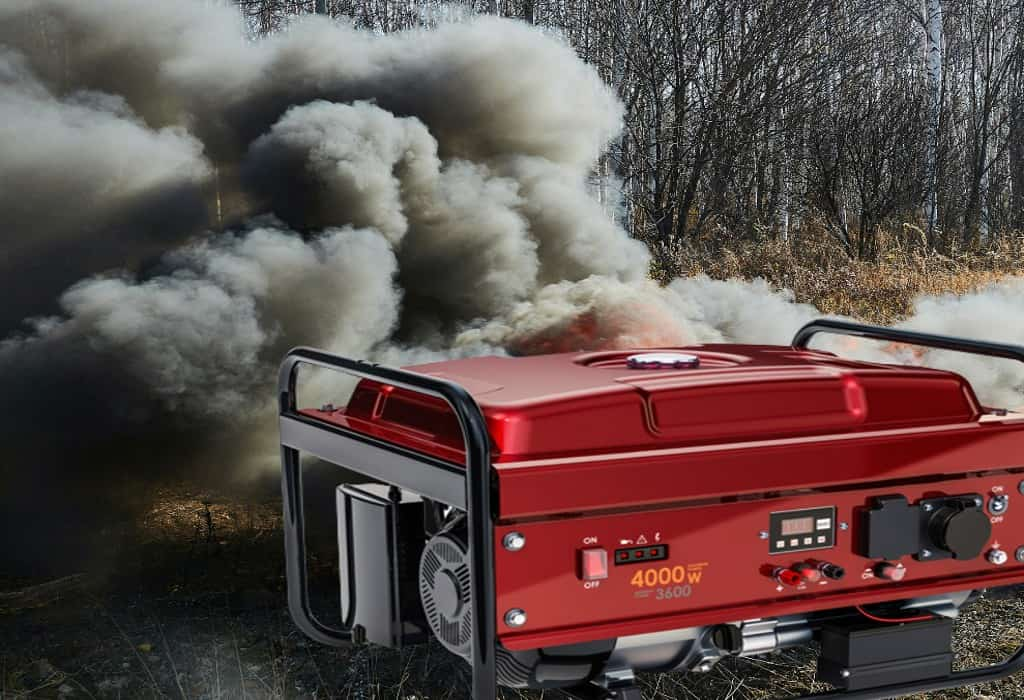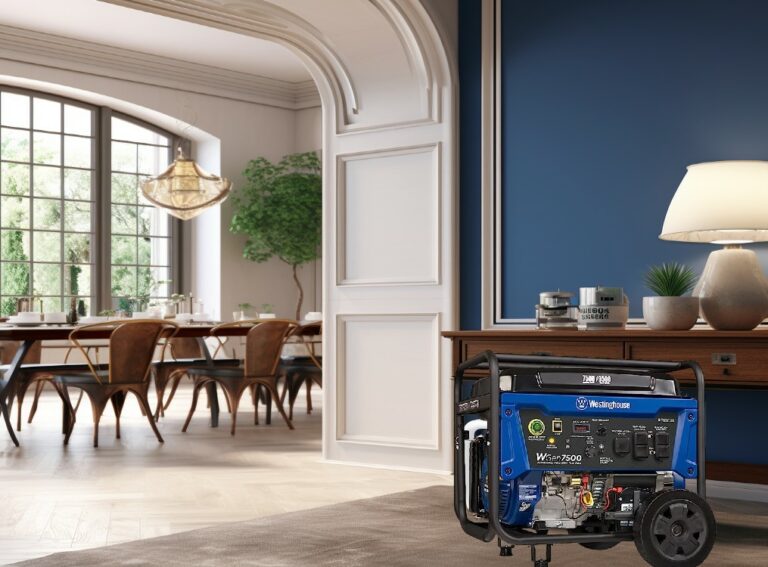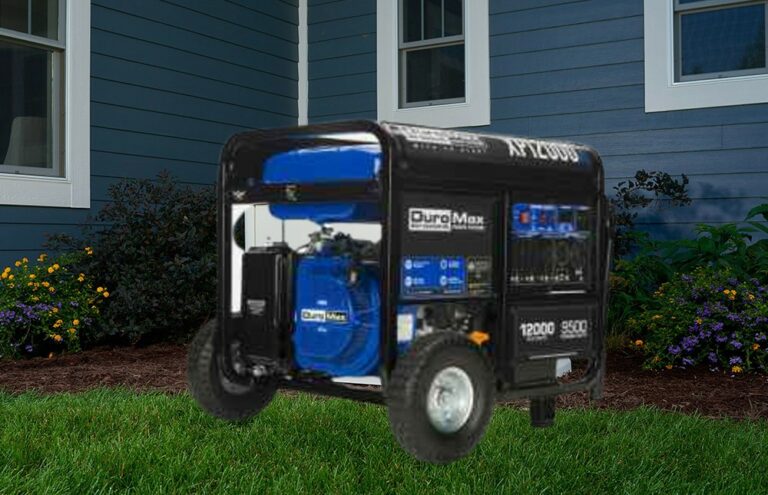Generator Backfiring After Shutting Off: Causes and Fixes

I’ve had my fair share of generator backfiring after shutting off, and let me tell you, it’s not a pleasant experience. Imagine this: you’re enjoying a peaceful evening, the generator slowly powering down after a long day of use, when suddenly, a loud pop resonates through the air, followed by bursts of flame. It’s enough to startle your neighbors and leave you concerned about potential damage to your generator.
But don’t worry; we’ll explore the causes, symptoms, and remedies for generator backfiring after shutting off.
Symptoms of Generator Backfiring
I hear a loud popping sound from the exhaust when my generator backfires after shutting off. It’s quite alarming and often startles my neighbors and me.
The mini-explosion or flash of flame in the exhaust can be quite intimidating, and I worry about potential damage to the exhaust manifold. It’s not the type of attention I desire.
I’ve understood that the backfire occurs due to the unburnt mixture of air and fuel that enters the hot exhaust manifold. The engine’s momentum persists for a short moment after shutting off, and that’s when the air-fuel mist spontaneously ignites in the hot exhaust.
To prevent this occurrence, I have started allowing the generator to run at idle speed for a minute prior to turning it off. It appears to have helped reduce the intensity of the backfire.
Reasons for Generator Backfiring
Spontaneous combustion can occur in the hot exhaust manifold due to an ignition source, fuel, and air. When a generator’s engine is turned off, the unburnt air-fuel mixture can be pumped into the hot exhaust manifold. This occurs because the engine’s momentum continues even after shut-off.
In the hot environment of the exhaust, the air-fuel mist can spontaneously combust, causing a loud popping sound and potentially damaging the exhaust manifold. It can be quite alarming for both the generator owner and their neighbors.
To prevent this backfiring, it is important to allow the engine to return to idle before shutting it off completely. This will help cool down the engine and reduce the piston momentum, minimizing the chances of spontaneous combustion.
Fixes for Generator Backfiring
To tackle the backfiring issue, I can ensure that the generator operates at idle speed for a minute before shutting it down. This allows the engine to cool down and decreases the likelihood of a backfire.
Additionally, changing our behavior to avoid sudden shutdowns at high RPMs is essential to prevent backfiring. It is also crucial to use the appropriate fuel and a blend without ethanol, if possible, as this can help avoid backfiring.
Lastly, following the recommended amount of fuel stabilizer per gallon and checking the carburetor settings for a rich air-fuel mix can further minimize the risk of backfiring.
Preventing Generator Backfiring
Preventative measures must be taken to minimize the risk of generator backfiring. As someone who wants to be part of a responsible generator user community, I understand the significance of preventing this occurrence.
To avert this issue, allowing the engine to return to an idle state before completely shutting it down is vital. Moreover, cooling down the engine aids in reducing piston momentum, thereby preventing potential backfires.
Considering the use of fuel additives and selecting the appropriate fuel type can also contribute to preventing backfiring. Regularly inspecting the carburetor for proper settings and utilizing video resources for guidance on carburetor cleaning ensures a seamless shutdown process.
Best Practices for Turning Off a Generator
When shutting down my generator, I ensure the engine is turned off at an idle speed to prevent any potential issues. Following the best practices for turning off a generator to maintain its longevity and prevent any backfiring is important. Here are four key points to consider:
- Turn off the engine shut-off switch at idle: This allows the generator to gradually come to a stop, reducing the risk of backfiring.
- Properly store the generator: If you’re stopping temporarily, make sure to turn off the engine shut-off switch at idle. Drain the fuel or use the fuel shut-off switch for long-term storage to prevent fuel-related issues.
- Allow the engine to use residual fuel: Before shutting off the generator completely, let it run until it uses any remaining fuel. This helps prevent the formation of varnish or sludge in the fuel lines and carburetor.
- Follow step-by-step shutdown instructions: Video resources are available to guide you through turning off a generator properly. Following these instructions can ensure a smooth shutdown and avoid any potential problems.
Loud Popping Sound From the Exhaust
After acquiring knowledge about the best practices for shutting down a generator, I aim to address a specific symptom that may arise: the resounding popping sound emanating from the exhaust.
This auditory occurrence can be rather disconcerting, notably if one lacks familiarity with its root cause. The primary reason behind this phenomenon is typically the injection of an unburnt mixture of air and fuel into the heated exhaust manifold. The engine’s momentum persists for a moment after cessation, thereby leading to the spontaneous combustion of the air-fuel mist within the scorching exhaust system.
Fortunately, remedies exist for this predicament. Allowing the generator to operate at idle speed for approximately one minute before shutting it down can help alleviate this issue. Modifying one’s behavior to avoid abrupt termination at high RPMs and utilizing the appropriate fuel and fuel stabilizer can also yield positive results.
Unburnt Air-Fuel Mix Pumped Into Hot Exhaust Manifold
To address the unburnt air-fuel mixture entering the hot exhaust manifold, I can ensure that the generator can run at idle speed for a minute before shutting it down. This allows the engine to cool down gradually, reducing the risk of backfiring.
Additionally, other steps can be taken to prevent this problem.
To begin with, it is important to avoid sudden shut-off at high RPMs, as this can cause the engine’s momentum to persist after shut-off, potentially leading to backfiring. If feasible, utilizing the appropriate fuel and considering the utilization of an ethanol-free blend can help deter the formation of unburnt fuel in the exhaust.
In addition, adhering to the recommended amount of fuel stabilizer per gallon is crucial to maintaining stable and combustible fuel. Regularly inspecting the carburetor settings to ensure a proper air-fuel mixture is also essential, as a rich mixture can contribute to backfiring.
Following these measures can minimize the likelihood of unburnt air-fuel mixture entering the hot exhaust manifold and prevent generator backfiring after shut-off.
Allow the Generator to Run at Idle Speed Before Turning it off
I always ensure that my generator runs at idle speed for a minute before shutting it down. This simple practice has helped prevent the generator from backfiring after powering it off.
By allowing the generator to run at idle speed before shutting it down, I allow the engine to cool down and reduce its momentum. This not only prevents the unburnt air-fuel mixture from being pumped into the hot exhaust manifold but also minimizes the chances of a violent backfire.
It is a small step that significantly contributes to maintaining the proper functioning of my generator and ensuring the safety of those around me. Therefore, if you wish to be part of a community of responsible generator owners, remember to let your generator run at idle speed before turning it off.
Properly Store the Generator to Prevent Backfiring
When storing my generator, I ensure proper fuel drainage or utilize the fuel shut-off switch to prevent potential backfiring incidents. Taking these precautions is crucial because backfiring can result in loud noises, small explosions, and exhaust manifold damage. Moreover, it can be embarrassing and disruptive to the neighbors.
To guarantee a smooth shutdown and avoid backfiring, I follow these best practices:
- Allow the engine to return to an idle state before shutting it off.
- Provide the engine with sufficient time to cool down and reduce piston momentum.
- Consider the use of fuel additives and select the appropriate fuel type.
- Regularly inspect the carburetor for proper settings and perform cleaning when necessary.
Frequently Asked Questions
Can Generator Backfiring After Shutting off Cause Damage to the Engine?
Yes, the generator backfiring after shutting off can damage the engine. The forceful explosions and excessive heat can cause harm to components such as the exhaust manifold. It is imperative to address this issue to avert further damage.
Is It Normal for a Generator to Backfire Occasionally?
Occasionally, my generator experiences backfiring, which results in a resounding bang and a brief burst of flame. This occurrence may startle nearby residents, but rest assured; it is generally harmless. Allow me to elaborate on the reasons behind this phenomenon and provide some measures to prevent it.
To begin, let’s understand the nature of generator backfiring. Instead of using the aforementioned terms, let’s delve into the intricacies of this issue. When a generator backfires, it emits an abrupt explosion and a momentary flicker of fire. This can be quite startling for those in the vicinity but fear not; it typically poses no significant danger.
Now, let’s discuss the reasons behind this occasional backfiring and how to minimize its likelihood. Instead of enumerating them as ‘first, second, and third’, let’s examine these factors more comprehensively. In light of preventing backfiring incidents, it is crucial to pay attention to a few important aspects.
One factor that contributes to backfiring is an improper air-fuel mixture. Not to mention issues with the carburetor or fuel injectors can also be the culprits. A dirty air filter or a clogged fuel line can lead to this problem. Identically, an overly rich or lean fuel mixture can also trigger backfiring.
Furthermore, it is important to keep an eye on the spark plug and its condition. Like all generator components, the spark plug can wear out over time, which may result in backfiring. The timing of the spark ignition can also play a role in this occurrence.
To prevent generator backfiring, it is crucial to maintain and service your machine regularly. Firstly, make sure to inspect and clean the air filter, as well as the fuel line, to ensure they are free of debris and contamination. Secondly, consider checking and adjusting the carburetor or fuel injectors if necessary. Thirdly, keep a close watch on the spark plug and replace it if it shows signs of wear or damage.
However, if you have followed these precautions and your generator still experiences backfiring, it may be wise to consult a professional for further assistance. In conclusion, occasional backfiring is not only common but also manageable. By taking the necessary preventive measures and conducting regular maintenance, you can ensure your generator operates smoothly without any disruptive pops or flames.
Can Use the Wrong Type of Fuel Cause Generator Backfiring?
Using an incorrect fuel type can lead to generator backfiring. This can result in unburned fuel being present in the exhaust, which has the potential to ignite and cause a loud popping noise or even a small explosion.
How Long Should I Let My Generator Run at Idle Before Turning It Off?
I typically allow my generator to run at idle for approximately one minute before shutting it down. This practice aids in the engine’s cooling process and reduces the chances of backfiring. Furthermore, it provides me with a sense of tranquility.
Can Generator Backfiring Be Prevented by Adjusting the Carburetor Settings?
Adjusting the carburetor settings can indeed assist in preventing generator backfiring. This adjustment ensures the appropriate blend of air and fuel, reducing the likelihood of unburnt fuel accumulating in the exhaust manifold and causing backfiring. Delving into these carburetor settings is crucial to maintain a harmonious air-fuel mixture. By doing so, we can effectively sidestep the issue of generator backfiring.
In the light of the aforementioned information, it is important to note that adjusting the carburetor settings prevents backfiring by optimizing the air-fuel mixture. This is not to mention that a proper adjustment can equally minimize the presence of unburnt fuel in the exhaust manifold, thereby avoiding any potential backfiring incidents. It is equally important to understand that adjusting carburetor settings plays a unique role in preventing backfiring.
Like a well-orchestrated symphony, the carburetor settings work harmoniously to ensure the generator’s optimal performance. The adjustment of these settings, as well as the subsequent reduction of unburnt fuel in the exhaust manifold, are crucial steps in preventing backfiring. Adjusting the carburetor settings promotes a balanced air-fuel mixture but also assists in avoiding any untoward incidents caused by backfiring.
Conclusion
Dealing with generator backfiring after shutting off can be a frustrating and potentially dangerous issue. The loud popping sounds and mini-explosions can create a sense of chaos and violence.
Yet, understanding the reasons behind this problem and implementing the suggested fixes and prevention methods can help us regain control and prevent further damage.
By juxtaposing the potential danger with the sense of control and prevention, we can navigate this issue with confidence and peace of mind.





